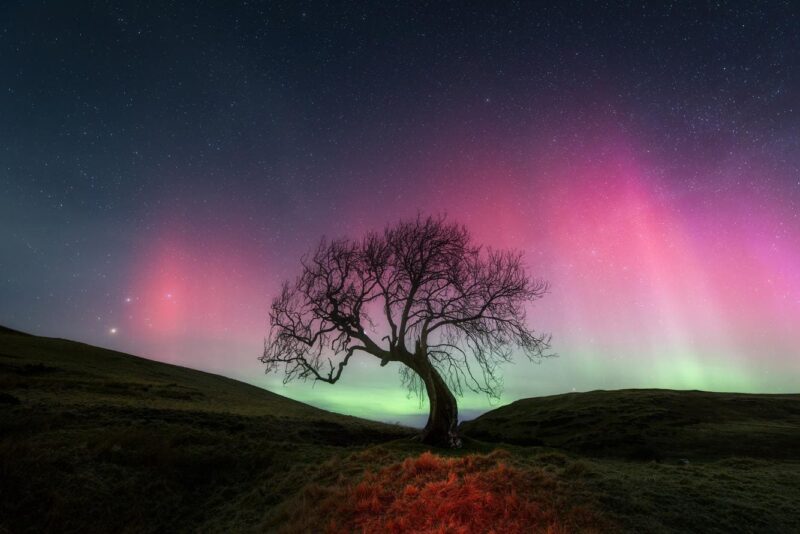Strong Pink – Green aurora over a very unique tree in Perthshire.
getty
The Northern Lights may be visible in northern skies across 15 northern U.S. states and Canada as soon as it gets dark on Tuesday, Nov.25, according to a forecast from the National Oceanic and Atmospheric Administration’s Space Weather Prediction Center. The forecast includes a G1-rated geomagnetic storm.
It comes in the wake not of a solar flare or a coronal mass ejection, but as Earth is doused by an unusually turbulent solar wind. It means an increased chance of aurora at high latitudes, but also farther south if things intensify.
Northern Lights Forecast: What To Expect
The latest forecast calls for a G1 geomagnetic storm after dark in North America on Tuesday, Nov. 24, stretching into the pre-dawn hours of Wednesday, Nov. 25.
NOAA predicts that “the geomagnetic field is expected to continue at unsettled to active
levels, with G1 (Minor) geomagnetic storms possible, on 24 Nov. On 25
Nov and through 26 Nov field activity is likely to reach G1 (Minor)
geomagnetic storm conditions due primarily to the influence of a
positive polarity coronal hole.”
According to NOAA’s aurora view line, 15 states could see displays of the Northern Lights in northern skies.
NOAA’s aurora viewline on Tuesday, Nov. 24, 2025.
NOAA
Northern Lights Forecast: Where And When
NOAA’s latest aurora viewlines indicate that aurora displays are a possibility in northern U.S. states and Canada, with 15 U.S. states having a chance after dark on Tuesday, Nov. 25.
U.S. states that may see aurora include Alaska and (northerly parts of) Washington, Idaho, Montana, Wyoming, North Dakota, South Dakota, Minnesota, Iowa, Wisconsin, Michigan, New York, Vermont, New Hampshire and Maine.
Urban glow is the aurora’s worst enemy. For the best views, locate a dark place using the Dark Sky Place Finder and a light pollution map. The darker the northern sky, the more vibrant the display — even during moderate geomagnetic storms.
Northern Lights Forecast: Latest Updates
To check visibility in real time, use NOAA’s 30-minute aurora forecast, or download apps such as Aurora Now, My Aurora Forecast or Glendale Aurora for up-to-the-minute alerts and live solar wind data.
Aurora-chasers frequently use the Kp index to predict the intensity of a geomagnetic storm, but for aurora displays, the interplanetary magnetic field’s Bz component is more important (you’ll find it in some of the above apps and on SpaceWeatherLive.com). Bz determines how easily solar energy enters Earth’s magnetosphere. When Bz points north, Earth’s field resists it; when Bz swings south, the two fields connect, allowing plasma to stream in. A sustained southward Bz of −5 nT or stronger usually signals an imminent display of aurora.
A panorama of the arc of Northern Lights seen August 26, 2019 about 11:30 p.m. CST from Grasslands National Park, Saskatchewan. (Photo by: Alan Dyer/VWPics/Universal Images Group via Getty Images)
VWPics/Universal Images Group via Getty Images
Northern Lights: Why To Travel For The Best Displays
To almost guarantee seeing the Northern Lights, aim to be under the auroral oval, which spans latitudes between 60 and 75 degrees. That includesAlaska, northern Canada, northern Norway, Sweden, Finland, and Iceland. In these latitudes, auroras are visible several nights per week from September through March.
However, clear weather is impossible to guarantee. Stay for at least three nights to improve your chances, and check local forecasts before venturing out.
Wishing you clear skies and wide eyes.









